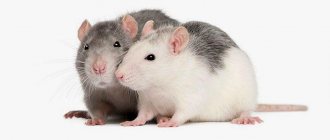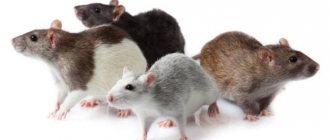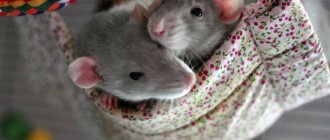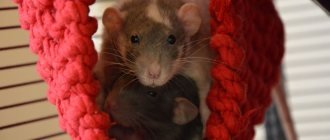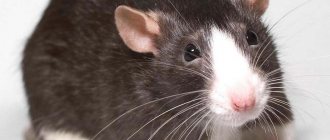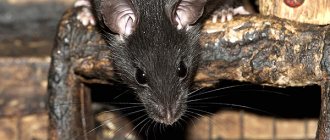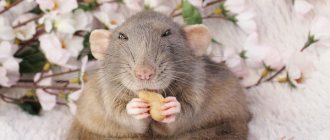The rat is considered one of the most intelligent and cunning species of rodents. And if you are now wincing with disgust and hostility towards this animal, then, most likely, you thought about the inhabitants of garbage dumps and basements, who are capable of carrying a myriad of diseases and infections. Another thing is decorative rodents, which can become an excellent friend for a pet lover in small apartments.
About who rats are, how they behave, what diseases domestic rats have, how to properly care for them, whether it is possible to wash decorative rats and much more - in our article.
Rat as a pet
Whatever animal you choose as a pet, you should remember the responsibility to the animal: it will have to be looked after, fed and loved, regardless of size, activity and type.
Often, future owners of four-legged animals mistakenly believe that if the animal is large, then there is a lot of trouble with it, and if it is small, then it does not require time. But in reality it's not like that. And often a tiny decorative rat requires more care than a huge guard dog. Therefore, if you are not ready to take on a number of responsibilities for caring for an animal, think about whether you want this responsibility or should you wait.
Fruits
- Citrus fruits are prohibited for consumption, because may cause allergic reactions due to increased acidity. A piece of tangerine is allowed as a treat (sometimes).
- Forest/garden berries – the acidity of the berry must be taken into account. Cranberry is very useful, but you need to give it a little and watch the reaction.
- Pear – may cause fermentation, should be given occasionally.
- Plum – has a laxative effect, its use in the diet of rats is undesirable.
- Watermelon/melon – a small amount is allowed, but must be seasonal.
- Dried fruits can also provoke fermentation; they are given occasionally as a tasty treat.
It is important to know that eating seeds from berries and fruits is unacceptable; they are very harmful to animals and can cause poisoning.
Breeds of domestic rats
Today there are 137 species of domestic rats, as well as 570 subspecies . And each of them is interesting in its own way. The most common:
- breed of decorative rat - standard,
- tailless rats,
- rexes and double rexes,
- satin types,
- hairless,
- decorative dumbo rats,
- downy
At the same time, the color of decorative rats can be uniform, ticked (with a pattern) or combined. White domestic rats, gray domestic rats, and black decorative rats are often found. Less often - with hearts, spots and stripes.
Animal proteins
Twice, or even three times a week, animals are supposed to receive animal proteins. The following can be served at the table:
- boiled lean meat;
- hard-boiled chicken or quail eggs;
- mealworm, zoophobus (zophobas), gammarus;
- seafood;
- high quality cat or dog dry food.
From poultry, you can give chicken breast, but it is better to feed turkey, which is not fed with growth hormones. From ungulates you can take beef, lean lamb, and game. It is better to grind the boiled yolk with water so that the rat does not choke. You should not feed fatty pork and its derivatives to rats.
Store-bought beef should be soaked for 2-3 hours before cooking, and chicken should be boiled in several waters to remove harmful substances. Rats can suffer from allergies.
Keeping a rat at home
If you have no doubts about your decision to have a rat as a pet, be sure to find out all the features of keeping this type of rodent in your home.
For example, a rat has a very direct relationship with rodents - therefore, walking around the apartment, it will find something to chew on: from shoe laces to equipment wires. In this regard, the animal is either not allowed to go on such walks unattended, or all dangerous or valuable objects are removed in advance.
The second feature of the rat is its smell, which indicates the mark of the territory of residence. Ask yourself, are you ready for fragrant surprises?
Thirdly, rats are afraid of drafts and direct sunlight - you need to remember this when placing your pet’s cage (i.e., a window sill is definitely not a suitable place).
Please note that the comfortable air temperature for a rat is 18-21 °C (despite the fact that the body temperature of a decorative rat is higher than a human one - 38.3-39.3 degrees).
Cell selection
The best home for such a rodent is a large and spacious cage (not a jar, not a container or a box). You can buy it at any pet store - complete with ladders, house, feeder and drinking bowl or separately from them. Some owners make accessories for their pets with their own hands (let us just remember that plywood and cardboard are chewed off quite quickly, and the item will have to be replaced). Of course, the animal will really like and will not get bored with such elements as hanging shelves, a running wheel, swings, and branches that can be climbed. This will be especially appreciated by young individuals, but the “oldies” do not need so much entertainment when decorating the interior of the cage.
When choosing filler for the cage, give preference to large sawdust (small particles of wood species can get into the animal’s eyes, nose or ears and cause an allergic reaction). If you use paper as a bedding, it should be clean, without paint, writing or typography.
Cotton wool is not suitable as a filler!
The cage must be cleaned at least once a week. Be sure to do a complete disinfection to eliminate the risk of infecting your rat with parasites, bacteria and microbes that may appear in a dirty cage.
What a rat needs to be happy: six things that anyone who wants to have the symbol of the year should know
On average, you can buy an animal for 500 rubles
» href=»https://klops.ru/news/2019-12-17/205640-v-rossii-pered-novym-godom-spros-na-domashnih-krys-vyros-vdvoe»>demand for the 2020 symbol has increased -go - a rat. In the Kaliningrad region you can find both the bald sphinx and the husky, a rather large animal whose face pattern resembles the “mask” of dogs of the same breed. Such rodents cost up to 1,000 rubles. Ordinary decorative rats cost 100-150 rubles.
Kaliningrad biologist Natalya Danilkiv, in whose house the rats Belka and Strelka settled, named six conditions for a happy rat life.
Keeping a rat alone is inhumane; the animal will wither away. He needs to communicate with his owners and other animals. A rat can make friends with a guinea pig, dog, or cat.
It is better to take home a month-old baby after observing him before buying - if he is sociable and active, does not conflict with his relatives and does not sit huddled in a corner, then, most likely, he will get along well with you. You need to communicate with your pet every day: pick it up, stroke it, carry it on your shoulder. Such an animal will be affectionate and tame.
The rat needs a large cage, ideally with three zones - a dining room, a bedroom and a toilet. It is advisable to cover part of the house with a blanket.
It is ideal to put toys in the cage in which you can hide food - the rat will definitely get it. Animals love shiny objects. You can put a bath with water, but not all rodents like to bathe. Decorative rats are afraid of loud, sharp sounds and do not like strong odors.
4. Balanced food.
The basis of a rat's diet is made up of plant and grain feeds; you can also add protein foods, for example, mealworms. Balanced foods are sold in pet stores. The animals love porridge, meat, fish, chicken and eggs. Tap water should not be given - it is too hard and may cause kidney problems. You can give fruit drinks or weak tea. A piece of salt or lime will become a source of microelements.
Try to rearrange the cage at least sometimes: rats love to travel. Animals can be walked on a harness after being vaccinated against rabies and treated for fleas. Unlike hamsters, rats are active at any time of the day.
6. Observation by a veterinarian.
Rats have a short age - 3-4 years. Tailless breeds often suffer from joint dysplasia. Some species have a tendency to develop cancer. Rats have allergies and skin diseases. If the pet is inactive, eats poorly, and does not leave the nest, the help of a veterinarian is needed.
Nine facts about rats
- 1. They are fearless, inquisitive and intelligent. A rat can easily drink from a bottle with a narrow neck using its tail - it will lower it into the water and then lick it.
2. Rats' teeth grow throughout their lives. They are capable of chewing through iron and concrete. To grind down the incisors, you can put shells in the cage - they contain microelements.
3. The rat will let you know that it is in pain. The animal shrinks, tilts its head and wrinkles its muzzle. Wild rats, when in trouble, thus give their relatives a signal to escape.
4. A rat can attack a person out of hunger or while defending a nest. The animal can jump two meters and be up to 1.2 meters in length.
5. They are afraid of tickling. If you scratch a rat in the neck area, the rodent may “giggle.” He tilts his head, squints his eyes and presses his paws, and pleasure is noticeable on his face.
6. They can call for help. In case of danger or aggression, rats emit ultrasound, which humans cannot detect. That's what they call their relatives.
7. They love eggs and can carry prey in their front paws so as not to break them while moving on their hind legs.
8. They love classical music. This was proven by an experiment: three groups of rats were given the sound of a fan, rock music and the works of Mozart. By pressing a button, the animals could choose a melody. Most preferred the classics. No one chose the fan.
9. Able to sympathize. Scientists conducted an experiment during which a rat was separated from its family by a glass partition. She was fed, but her relatives were hungry and they were given weak electric shocks. A well-fed rat huddled against the glass and refused to eat. Rats can take care of a sick and weak brother.
Source
What to feed your pet rat?
It is not enough to know about the care and maintenance of a pet rat: feeding is an equally important aspect, because the pet constantly needs clean and fresh water and food. For liquids, a drinking bowl is placed so that the water does not spill and the cage does not become dirty and damp. The water needs to be changed every day.
The food should include grains (oats, wheat, millet, barley), fruits (apples, bananas, peaches, apricots, persimmons), berries (grapes, strawberries, raspberries), vegetables, herbs (dandelion and plantain leaves), dried fruits , nuts (except almonds) and chicken bones (necessary for grinding teeth). You can give meat, but in small portions and no more than once a week.
The normal feeding frequency is 2 times a day for adults, 3-4 times for children and adolescents.
Additionally, owners purchase a mineral stone that can provide the animal with the necessary amount of calcium.
List of prohibited products:
- roast,
- salty,
- smoked,
- fatty,
- spicy,
- cold,
- sweet.
So candy, chocolate, sausage, bread, soy are not an option. Vegetables such as cabbage, turnips, radishes, radishes, beets, legumes and raw potatoes should not be given. All permitted vegetables and fruits must be ripe (not green, but not overripe). Do not offer your rat leaves from indoor plants or fruit trees.
A properly selected diet is the key to animal health. It’s easy to put together if you know what pet rats eat and what you should absolutely not give.
What foods should not be given?
If you love your pet, then be sure to carefully approach the preparation of its menu. The rat's diet must be balanced, it must contain many vitamins and minerals. Of course, there should also be foods that they love - vegetables, fruits, berries. If you want to make a holiday for your rat, you can buy special candies for it at the pet store. You can also give a couple of pieces of watermelon, but these products should be given in limited quantities.
But there are certain types of foods that should not be given to these animals. The following food should never be in a rat cage:
- sweets – chocolate, confectionery, candies;
- carbonated drinks;
- sharp smoked cheeses, salted, with mold, especially feta cheese, fetaka;
- do not give artichokes;
- legumes;
- liquorice;
- green bananas;
- sprouted potato tubers;
- Brussels and red cabbage.
You should also not feed your pet certain herbs that can be highly toxic to rats:
- mistletoe;
- fern;
- azalea;
- lily of the valley;
- begonia;
- ivy;
- tomato leaves;
- tulips;
- daffodils.
You should definitely exclude all of the above components, as they can negatively affect the pet’s condition. It is best to include in your diet more foods that these animals love. Particular emphasis should be placed on components with a high content of vitamins, minerals, microelements - vegetables, fruits, berries, cereals and grain crops.
Diseases of decorative rats
Rats, like many other decorative rodents, can be overtaken by a variety of diseases, some of which are dangerous for humans. The causes of illnesses can be parasites, bacteria, viruses, fungi.
The following diseases are common:
- ectromelia (also known as smallpox) is a virus that, when it falls into the animal’s body, multiplies on the skin and internal organs (in the chronic form, ulcers, swelling and spots appear on the skin, which ends in tissue necrosis and gangrene; in the acute stage, there may be no symptoms, but the rat will die within 24 hours);
- listeriosis is a bacterial infection that is also dangerous for humans (infection occurs through bedding, food and cage accessories); body temperature rises, coordination is impaired;
- salmonellosis is a bacterium manifested by apathy, diarrhea, intermittent breathing, and without treatment it turns into edema, paralysis and irreversible organ damage (treated with antibiotics - chloramphenicol, biseptol, sulfadimethoxine);
- pneumonia - damage to the respiratory system by pathogens coronavirus and Sendai virus, manifested by discharge from the nose and eyes, sneezing, difficulty breathing, redness of the eyes, swelling of the throat, apathy, weight loss (treated with a course of antibiotics, anti-inflammatory drugs, immunomodulators and vitamins);
- mycoplasmosis - a genital, respiratory or mixed infection, manifested by enlarged lymph nodes, nasal discharge, pneumonia (the genital form may be asymptomatic);
- coccidiosis - a disease of the intestines and liver with frequent digestive disorders, jaundice, exhaustion;
- scab and actinomycosis are a fungus that enters the rat’s body after flea or tick bites, as well as through contaminated food (symptoms are ulcers, grayish blisters, scabs on the skin, hair loss, abscesses on the mucous membranes in the mouth).
Many diseases can be avoided if you wash your hands after handling your pet, give proven food and keep the animal’s cage clean.
Now you know how to care for a rat at home. Following all the recommendations is not very troublesome, but your smart animal will definitely thank you with its attention and love.
Milk products
All dairy products will be beneficial to your rat's health, but it is important to be aware of the possibility of a lactose allergy. It is advisable not to give pure milk, but other fermented milk can be given, but without fanaticism, you need to introduce new products little by little, observing the reaction. It is also undesirable to consume homemade sour cream/cream/cheese; often such products have a high fat content, which can cause digestive disorders.
Possible and useful:
- cottage cheese;
- fermented baked milk;
- pure yogurt;
- kefir.
Any fermented milk product should have no more fat than 4%. When it comes to low-fat products, it is advisable to choose non-perishable or children's dairy products.
